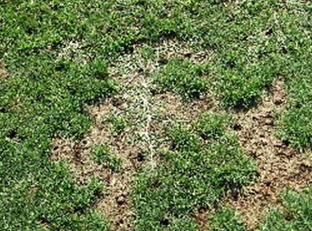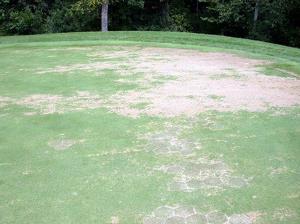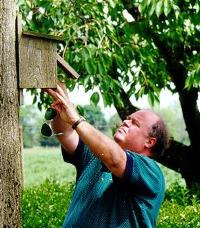|
|
|
|
|
September 23, 2011 -- Volume 49, Number 38 |
|
| A Giant Leap Forward | How soil moisture meters are changing the game of putting green irrigation
by Randy Gatlin, Golf Course Superintendent, Robert Trent Jones Trail at The Shoals |
 | |
Superintendent Randy Gatlin
|
Moisture management is one of the most important aspects of bringing creeping bentgrass putting greens through a southern summer. Too much moisture encourages maladies such as leaf and root diseases, softness, more susceptibility to mechanical damage, algae, etc. Too little moisture brings on wilt, higher canopy temperatures, and potential for more localized dry spot. At The Shoals (Muscle Shoals, Alabama), we strive for the optimum level of moisture each day to give the bentgrass the best chance to thrive despite soil and air temperatures that are often hostile.
In 2010, we obtained a Field Scout 300 TDR Soil Moisture probe from Spectrum Technologies. Almost immediately we began learning nuances about the putting greens, their performance, and the irrigation system distribution. This article will discuss some discoveries we made using the Field Scout on a daily basis and reveal how we use the Field Scout plus a GPS receiver as a diagnostic tool.
To see how Randy uses this tool for:
- Informal Audit of Irrigation Coverage
- Estimate Daily Moisture Loss Through Evaporation
- Early Detection of Wilt Symptoms
- Management of Extremes / Crisis Management
Read the rest of this article
|
The Drought Might Have You Down
But You Better Not Be Out | The Most Critical Time Is Here - Are You Ready?
by James Francis Moore, USGA agronomist |
 | |
You know the ground cracks are getting bad when you start losing sand out of the bunkers!
|
The drought and heat of 2011 has persisted for so long in some parts of the country that it is old news - even though the damage is everywhere you look. Months of 100 degree plus temperatures and a landscape that is so burned and brown it looks more like mid-winter tends to dull the senses after a while.
Golfers have learned to deal with more dirt in fairways than grass, tees with 3-inch cracks in them, and dried up lakes. Dust flies not only when a ball is struck from the fairway, it flies again when it lands in the fairway.
It has been a tough summer to say the least. So it is understandable that many of us are anxiously looking forward to the cooler months when things can settle down a bit. However, for golf course superintendents and course owners this would be a big mistake.
The next 4 to 6 weeks are the most critical of the year given the weakened state of bermudagrass across the region. This brief presentation offers a number of steps that need to be taken right now or else the damage next spring may make this summer look easy.
Note - depending on your Internet connection, this presentation may take a couple of minutes to load completely. Be patient!
Watch this presentation
|
|
Regional Updates
|  Mid-Atlantic Region Mid-Atlantic Region
by Darin Bevard, senior agronomist
| |
Necessary Weed Control Measures This Fall
The first real cold front of the fall season swept through the area in the past week, bringing in much cooler temperatures. This is welcome relief for the grass in what has been a long, and for much of the time, hot growing season. Fall offers the opportunity for some of the best golf course conditions of the season.
 | During the heat of the summer, bermudagrass populations will expand into areas of weak turf or bare ground. Control of bermudagrass in cool-season fairways is extremely challenging.
. |
With shorter days and cooler temperatures, turf growth is slowing rapidly. Unfortunately, rainy weather patterns have limited opportunities to consistently groom fairways and greens for optimum playability. Temperatures are more favorable for cool-season grasses, but under wet conditions, mechanical damage can occur. Thus, with wet weather, it may be necessary to suspend mowing until turfgrass areas dry out. These delays in mowing can be difficult to implement, but this will prevent rutting of turfgrass areas and other damage. Be patient, and don't inflict damage on yourself.
One area of difficulty in 2011 has been weed control. Oftentimes, weed control is an afterthought. In the past, preemergence herbicides in the spring, along with one or two broadleaf applications, were made per growing season and the golf course was reasonably well weed free. This has been changing in recent years, with increasing populations of more difficult-to-control weeds that have proven to be far more challenging to control.
Read the rest of this update
 North Central Region
by Bob Vavrek, senior agonomist
Tick, Tock, Tick, Tock
 | | Recovery from mid-summer losses of turf will be a challenge if you wait until Labor Day to start the process. Poa will have a better chance of establishment versus bentgrass now that days are shorter and nights are cooler. |
Time is running out, along with daylight and high soil temperatures, for those still trying to recover from the turf losses caused by this summer's heat wave. I'm amazed that some courses are just starting to seed into thin and bare areas on greens and expect full recovery before winter arrives. After all, the weather has not cooperated all season, so why should it start now?
Granted, soil temperature are still pushing upper 60's during mid-day and you might see green bentgrass fuzz on a freshly-seeded site within 10 days or so, if (and a BIG if) the mild weather holds up and nights don't become too chilly. Small, isolated dime- to quarter-sized areas of thin turf can recover when bentgrass creeps in from the borders, but large bare areas need seed, heat and time. Why the pessimism? Do the math. Let's say you began the process the day after Labor Day.
Seeding bare area until you see green fuzz------------------------------------ 10 days
Fuzz grows high enough to mow a few times--------------------------------- + 10 days
Several topdressings and mowing height adjustments
to encourage turf to fill in between seed lines or aeration holes------------- + weeks
----------------------
= November
Read the rest of this update
|
| USGA Holiday Cards | Share your love of the game
| 
The USGA Holiday Card Center offers you a wide selection of 25 high-quality Christmas and general holiday card choices for your personal and corporate greetings. Many personalization and business options are available, including logo and signature imprinting, as well as return-address labels and printed envelopes.
Visit the USGA Holiday Card Center
|
| Forward The Record To A Friend | It's Easy To Share This Publication With Others
by the USGA Green Section Staff | Each Green Section Record issue includes articles and information that appeal to golfers and those who work in the game. Please help us distribute this publication as widely as possible. The best way to do this is to click the "Forward to a Friend" button below.
Thanks for your help! |
| Green Section Record Archive | Looking for a previous issue of the Green Section Record?
|
 | |
Looking for something?
|
The Green Section Record has been published under various names since 1921 and iscomposed of an amazing collection of full-text articles and photos. This collection is stored and maintained by the wonderful library staff at Michigan State University in the Turfgrass Information File (TGIF). All past issues of the Record, including this one, can be accessed free-of-charge by following this link.
Search the Green Section Record |
The USGA Green Section Portal
| A Valuable, Free Resource
|
Take a minute to visit the Green Section's portal at http://gsportal.usga.org to find information regarding upcoming live webcasts and links to recordings of more than 30 previously-delivered webcasts and announcements of upcoming USGA Green Section activities, education conferences, and meetings.
|
|
|
|
| USGA Green Section
P.O. Box 708
Far Hills, NJ 07931-0708
908.234.2300
| |

©2011 by United States Golf Association®
Permission to reproduce articles or material in the USGA Green Section Record is granted to
newspapers, periodicals, and educational institutions unless specifically noted otherwise. All materials
must be used in their entirety. Credit must be given to the author, the article's title, the USGA Green
Section Record, and the issue's date. Copyright protection must be afforded. No material may be
copied or used for any advertising, promotion or commercial purposes.
Green Section Record (ISSN 2156-5813) is published weekly via electronic mail by the
United States Golf Association®, Golf House, Far Hills, NJ 07931.
|
|
|
|
|
|